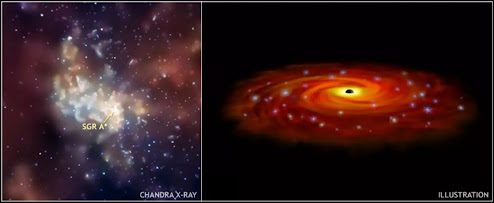The Milky Way galaxy | Sun's location in Milky Way | Milky Way band | Galaxies Part-1
The Milky Way is our own galactic town with billions of
stars, gas & dust clouds and dark matter held together by gravity. It is a
type of spiral galaxy (disc shape), which is 1,00,000 light years across and
several light years thick. The disc has two major spiral arms called
Scutum Centaurus & Perseus arms and two minor one's called Norma &
Sagittarius arms with huge bulge at the centre. It was measured that the bulge
at the centre is about 20,000 light years long.
Milky Way at night?
When you are in a dark place on a moonless night, you can
watch the huge bulge resembles like a pathway stretched out with glow called
the 'Milky Way band'. Since ancient times, we are watching this beauty and the
ancient Greeks named the glow as the ‘Galaxius’ or ‘Milky’ which later termed
as ‘Milky Way’ or ‘The Milky Way galaxy’.
 |
| The_Milky_Way_band_from_Earth_Into_the_dark_space Image Credit: ESO/P. Horálek https://www.eso.org/public/images/potw1938a/ |
Actually, what is that glow?
Since ancient times, it was thought to be cloudy bulge
glowing in the midnight. It was thought to be the same until the late 1600's,
when the man called Galileo Galilei pointed his new crafted telescope towards
the Milky Way band. He was shocked to see that they were thousands of stars
closed together forming this glow. Some of them are so faint that we can't see
with our naked eye. It consists of interstellar dust blocking the most of the
visible light from our view towards the galactic centre.
Location of the Sun in Milky Way :
The Sun is located at a distance of about 25,000 light years
away from galactic centre in Orion arm (suburbs) lying between the Sagittarius
and Perseus arms. The sun takes about 250 million years to orbit the Milky Way
galaxy which means, until now it completed only 20 orbits after birth.
 |
| Milky_Way_with_Sun's_location_Into_the_dark_space Image Credit: NASA/JPL-Caltech/R. Hurt (SSC/Caltech) |
The bright, young and massive stars are in the spiral arms
and none of the stars are in between the gaps orbiting the galactic centre.
The spiral arms looks blue due to the presence of luminous,
blue and hot stars. Nebulae in the spiral arms forming stars can light up the
gas around them and produce glow in them. The majority of the stars are born in
these spiral arms, so they are crowded hugely. The bulge at the centre consists
of old, reddish and lower mass stars with very low chances of star formation.
The gravity is all over the disc spreading out huge area. The
huge bulge with arms orbit as a single unit unlike of solar system, meaning the
stars at the edge make one orbit in the same time as the stars closer in.
In 1980's, it was thought to be a super massive black hole
sits at very centre of the Milky Way galaxy with 4 million times the mass of
the Sun called Sagittarius A*. Later through research, we found that the
assumption was correct. It may played a very big role in the galaxy formation
and evolution.
 |
| Sagittarius_A*_Galactic_Center_Into_the_dark_space Image Credit: X-ray: NASA/CXC/MIT/F.K.Baganoff et al.; Illustration: NASA/CXC/M.Weiss |
The Milky Way consists of a halo surrounding the spirals,
which is dark and most of the stars in it are old. No star formation occurs
there. The halo is densely packed with most of the globular clusters. It is
estimated that, it was 11 to 12 billion years old. Even our own galactic town,
The Milky Way galaxy also supported the life to exist on Earth.
Share your ideas and thoughts in comment section below.
For more information click here and for updates please follow my site,
Thank you.
Superb
ReplyDeletethank you
DeleteWow great
ReplyDeletethank you
DeleteGood information
ReplyDeletethank you, Follow for more info
Deletenice ....anna
ReplyDeleteThank you bro
Delete